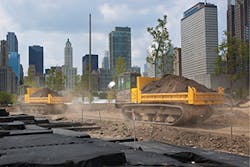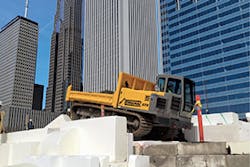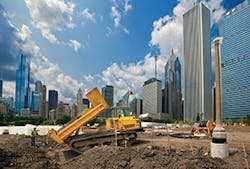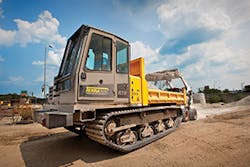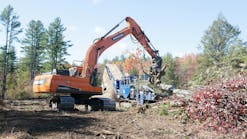Project Profile: Terramac RT9 Crawler Carriers Are Kings of the Hill on Maggie Daley Park Project
When it came time for some much-needed roof repairs to the vast parking garage beneath the northeast corner of Chicago’s Grant Park, the Chicago Park District used the opportunity to transform 25 acres of greenspace into a concept park similar to the nearby Millennium Park. Currently under construction, the site is bordered on the north by Randolph Street, on the east by Lake Shore Drive, on the south by Monroe Street, and on the west by Columbus Drive.
Not Your Average Neighborhood Park
The park district’s primary goal for the park, named in honor of Chicago’s former First Lady, Maggie Daley, was to create an environmentally sustainable park that would appeal to the city of Chicago and tourists alike. Once complete, the park, which encompasses the Daley Bicentennial Plaza, Cancer Survivors Garden, and Peanut Park, will include landscaping, rock-climbing sculptures, a one-of-a-kind ice-skating ribbon—a winding river that wraps around a section of the park—a play garden, a field house, three large open lawn areas for events, and picnic areas.
According to the Chicago Park District, funding of the Maggie Daley Park development is estimated at $55 million, which includes park capital funds, funds from the downtown parking garage lease and other privately raised funds.
The first phase of the project included removing 22,500 cubic yards of top soil, 82,000 cubic yards of fill, 104,500 cubic yards of soil, and 800 trees to expose the parking deck for waterproofing, and to create some initial foundations for structural items and footings for light poles. The soil was moved temporarily to Peanut Park, just east of Maggie Daley Park, for reuse on the project.
Phase Two
Walsh Construction Company II LLC, was awarded the second phase of work for the renovation. Based in Chicago, Walsh Construction has worked on other major city projects, including the East Monroe parking garage, the Wacker Drive reconstruction and the Millennium Park parking garage.
“We have about 90 people working this job site,” says Robert Bolt, senior project superintendent, Walsh Construction. A Chicago southsider, Bolt has worked for Walsh Construction for 35 years. He and his crew are handling site preparation, concrete foundations, fencing, irrigation, soil installation, and landscaping. They are also building the children’s play garden, rock-climbing walls, and the ice-skating ribbon.
“Underneath the park are two stories of the Grant Park parking garage recently renovated by Walsh Construction,” says Bolt. “The garage was designed back in the 1960s to handle about four feet of dirt, plus live loads of fire trucks, ambulances, and crowds of people. The garage required a little waterproofing and asmall amount of structural work, which was handled by someone else.”
“Walsh Construction started on the project in the late fall of 2013, working on a series of drainage layers,” says Bolt. “We then delivered 570 semi-truck loads of geofoam, about 30,000 cubic yards of structural fill, and another 50,000 yards of topsoil.”
Moving dirt to shape Maggie Daley Park
The expanded polystyrene geofoam is a lightweight, environmentally safe and recyclable plastic foam fill material that is being used to create landscapes and hills on the 25-acre park site. The durable yet cost-effective material resists freeze-thaw damage, decomposition, and moisture, and has been in use around the world for more than 30 years. Depending on the density selected, geofoam is as much as 100 times lighter in weight than soil fills. The material allows the final grades of the site to vary in elevation without causing the concrete garage roof to be overloaded, and also allows for foliage to be planted, while keeping soil requirements low.
Where the Dirt Meets the Foam
The project called for the placement of geofoam and soil over a 16-acre space that sits directly over the top of the parking garage. Getting the geofoam placed was one thing, but covering the material with soil across such a large space was a challenge.
A solution would soon present itself in the form of two multi-purpose rubber track crawler carriers from Terramac LLC, a company based in the nearby town of Elburn, IL, less than 50 miles due west of Chicago.
“Walsh Construction had been looking at crawler carriers and came across the Terramac RT9 during an Internet search,” says Matt Slater, director of sales for Terramac. “They weren’t very familiar with crawler carriers and weren’t sure if the machines would even be able to travel across the job site without damaging the geofoam.”
Terramac invited Walsh Construction representatives out to their facility to test drive the RT9 crawler carrier earlier this spring. “Once they got into the machine, drove it around, and saw what it can do, they were sold,” says Slater.
Crawler Carriers Make Good Impression
Introduced in 2012 by Terramac, a manufacturer of innovative rubber track crawler carriers, the RT9 multi-purpose crawler carrier is built to tackle a wide variety of earthmoving, aggregates, construction, mining, and utility applications. The machine boasts a 10-foot turning radius, an overall length of 20 feet, a width of 8.4 feet, a height of 9.3 feet, and a minimum ground clearance of 20 inches.
At first, the crew wasn’t sure if the geofoam would support the weight of the two RT9 crawler carriers. Each machine has an operating weight of 26,000 pounds, and a maximum carrying capacity of 18,000 pounds. When fully loaded, the ground pressure on each RT9 is only 5.1 psi.
“The RT9s left marks in the geofoam, but there was no structural damage to the material,” says Bolt. “I’m allowed 5.8 or 5.9 psi on the geofoam. The RT9 crawler carriers leave temporary impressions in the material, but those impressions don’t last. The material is very resilient.”
Terramac pushes ahead with Maggie Daley Park Project
“With these machines, we can travel across the site on top of the geofoam with no problems,” says Virgil Ramirez, a project manager who has worked for Walsh Construction for seven years. “At one point, we had a 12-foot-high ramp made of geofoam and the RT9 crawler carriers climbed it just fine.”
Workers completed layering the top of the garage structure with geofoam and have been using the two Terramac RT9 crawler carriers to haul and dump soil and stone across the 25-acre site.
Reused Soil Laid Over New Landscape
The RT9s are hauling soil from Peanut Park and placing the first layers of soil above the thousands of yards of geofoam forming the base for the landscape. A customized conveyor belt is also being used to transport horticultural soil across the garage roof so crews can plant each of the nearly 1,500 trees in the park.
“Originally, the north half of the job was going to be handled by the two RT9 machines, and the south half would be handled by the conveyor system,” says Bolt. “We went three weeks with the conveyor belt system, and it worked as it should, but it was slower going, because the system has to be assembled in different layers.”
By the halfway point in the project, the crew continued to use the RT9s while the conveyor system was still being set up. “We just kept on going a little bit more with the RT9s,” says Bolt. “Now, we’re three-quarters of the way through the job, and we’re going to finish the project using the crawler carriers.”
Ideal for carrying supplies and materials, the bed on the Terramac RT9 crawler carrier elevates to a 48-degree angle for dumping gravel, sand, dirt, and other materials. The bed can fold down, allowing the operator to side-load materials.
500 Yards of Dirt Is a Good Day
According to Bolt, a slow day on the job site with both RT9’s at work usually yields about 40 loads of dirt total—or 20 loads per machine. “The dirt’s usually pretty dry, so we fluff it first and sift through the debris before loading onto the RT9,” says Bolt. We’re getting about 8.5 or 9 yards per load with each RT9 crawler carrier. On our better days, we can get up to 90 loads total—or 45 loads per RT9. An average day is about 60 to 70 loads total, so if we can move 500 yards of dirt a day, that’s pretty decent.”
Walsh Construction evaluated some competitive crawler carriers that reached speeds of 12–20 miles per hour, but Bolt says they were more expensive. “The top speed on the RT9s is about 7 miles per hour, but having seen these machines at work on this job, I would never even consider those other carriers. The Terramac RT9s were the only way to go for a job like this.”
Rain or Shine, RT9s Keep Project on Track
While the RT9s may not be the fastest machines in the world, Bolt admits that the crawler carriers have a hidden value they didn’t appreciate at first. “We’re used to being down for a day or two when the ground is saturated with rain,” he says. “That’s not the case with the RT9s. As soon as the rain stops, we can get right back to work. The RT9 crawler carriers literally float on top of the mud—better than any rubber tire machine.”
Because of the flotation from the RT9’s rubber tracks, these machines can keep working in all types of adverse ground and weather conditions, completing projects much faster. The rubber tracks also allow for faster climbing on hills and reduced slippage in wet conditions. Unlike steel-track crawler carriers, the RT9 rubber-track crawler carrier won’t tear up the ground or road surface—a significant advantage for preventing costly job-site ground damage.
“We had a lot of days where it had poured all night,” says Ramirez. “We’d wait a few hours and then we’d be right back out on the job thanks to the RT9s.”
Bolt says the RT9s allow his crews to go in new directions and create whole new tracks across the job site, even the day after a rain. “We had some really messy haul roads as a result of the rain, but after running the two RT9 carriers fully loaded for three straight days, those roads were as flat, solid and hard as can be.”
A Tank of Fuel a Day
The two RT9s are running all day on the job, morning through afternoon. Bolt says one of the RT9 operators can run the crawler carrier all day long on one tank of fuel. “He knocks the idle down once he’s in position, and then moves around and speeds it back up,” he says. “Just by doing that, he can run on one tank for the whole day. Now we’ve got the other RT9 operator following his lead and watching the throttle. If we can save on fuel stops, we can run a few more loads. A few more loads each day makes a huge difference.”
Walsh Construction is also using the two RT9 crawler carriers to haul as many as 8 loads of stone per day. “Some days, we’ll send the dirt crew home at the end of the day and use another crew to operate the RT9s to run stone for a little overtime,” says Bolt.
On Target for 2015 Completion
Despite slow progress during the brutal winter months, the earthwork, utilities, paving, architectural and program elements, soil placement, and planting were mostly completed in the fall of 2014.
“We’re hitting on all cylinders on this job now,” says Ramirez. “The Terramac RT9s are great as material handlers. They were a huge plus for us on this job.”
“We had a specific need for heavy-duty material handling for this job,” says Bolt. “And the RT9s were the perfect fit.”
Walsh Construction also completed its work on the park’s climbing wall and ice ribbon walls (the paved path that leads to the climbing wall). Work has also been completed on the installation of the play equipment.
While a soft opening was scheduled for fall 2014, the park in its entirety will be officially completed mid-2015.
Combined with Millennium Park, Maggie Daley Park will be the largest green roof in the world. “It’s a cool design—a cool park,” says Ramirez. “And it will be here forever.”
Current Chicago Mayor Rahm Emanuel agrees, describing the space as “a new jewel on Chicago’s lakefront, attracting visitors from Chicago and across the country to our vibrant downtown.”
